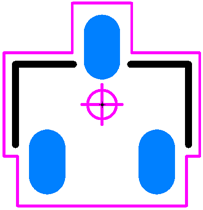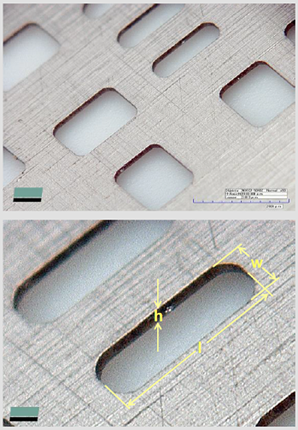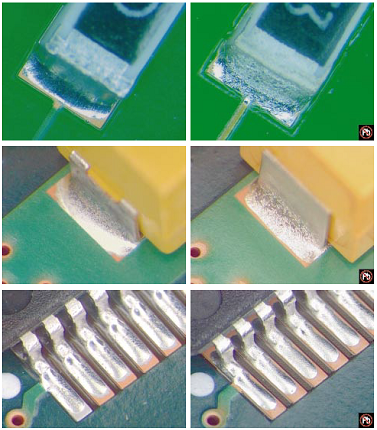IPC-7351 and SMD Pad Shapes
Printed From: PCB Libraries Forum
Category: Libraries
Forum Name: Footprints / Land Patterns
Forum Description: [General or a CAD specific issues / discussions]
URL: https://www.PCBLibraries.com/forum/forum_posts.asp?TID=2590
Printed Date: 10 Jan 2026 at 1:53pm
Topic: IPC-7351 and SMD Pad Shapes
Posted By: Tom H
Subject: IPC-7351 and SMD Pad Shapes
Date Posted: 30 Dec 2019 at 2:51pm
|
IPC-7351B recommends an Oblong
(or “Full Radius”) pad shape:
The component manufacturer’s recommend Rectangle pad shape:
PCB Libraries, Inc. recommends
a Rounded Rectangular pad shape: Paste mask stencil apertures
are laser cut with rounded corners. It makes sense that the pad shape and
stencil opening be the same. I heard of a marketing slogan
that mentioned “Rounded Rectangular pad shape is better for Lead-Free Solder”.
This is not true. All pad shapes are good with Lead-Free Solder. A better
statement would say “Rounded Rectangular pad shape is best. Period”. Rounded Rectangle pad shapes
were first introduced by the P-CAD software program 15 years ago. Then every
other CAD vendor came out with their version of the Rounded Rectangular pad
shape. The industry could not make Rounded Rectangular pad shape a standard or
even a recommendation until all CAD tools supported it. You can see that there is no
solder in the rectangular pad shape corners. The question is “Why use Rectangular
pad shape if there is no solder in the pad corners?”. The post reflow oven results
for Lead Solder on the left and Lead-Free Solder on the right. In the Library Expert software
program, the user has 100% control of the pad shape for every component family.
You also control the percentage of the pad width to auto-generate the corner
radius. You can also control the Maximum radius. However, there are some
component families that are “Bottom Only” terminal leads with square or
rectangular shape. The pad size is a simple periphery around the terminal lead.
These component families include DFN, LGA and PQFN with rectangle leads and the
resulting pad shape should also be rectangular. Note: many DFN packages are
less than 2.00 mm long and the pad size is 0.50 X 0.65 mm. Very small pad and
the pad shape needs to be the same as the terminal lead shape for the best
solder result as the pad and terminal lead size are 1:1 (same size). The D-Shape pad is becoming popular, but not all CAD tools
natively support this pad shape. As a result, the D-Shape pad is created from a
copper poly shape. This makes the library part file size much larger, depending
on how many pins are in the package. This translates to the PCB Layout file
being larger too. ------------- Stay connected - follow us! https://twitter.com/PCBLibraries" rel="nofollow - X - http://www.linkedin.com/company/pcb-libraries-inc-/" rel="nofollow - LinkedIn |
Replies:
Posted By: Tom H
Date Posted: 18 Dec 2023 at 6:19pm
|
Component packages are getting smaller and rectangular flat terminal leads are becoming popular. Flat square terminal leads like the Land Grid Array only require a 0.05 periphery to calculate the footprint. A 0.20 corner radius pad shape might expose the terminal lead. The terminal leads should always be on top of a pad and never be exposed outside a pad. There is no industry recommendations for the corner radius limit and no component manufacturers (except Texas Instruments) provide any guidance for the corner radius. A recommended pattern is provided in every new Texas Instruments datasheet and every recommended pattern has rounded rectangle pad shape with a corner radius of 0.05 mm. 0.05 mm is the same radius as the paste mask stencil aperture opening cut by laser. I wish there was more guidance from assembly shops or the IPC J-STD-001 Standard, IPC-7093A, IPC-7351B or IPC-7352 regarding rounded rectangle pad shape corner radius limit, but it seems that the only industry documentation on this subject comes from Texas Instruments. Normally, a corner radius setting in a CAD tool is global to all footprint patterns. When the setting is 25% of the pad width, larger pads will have a huge corner radius and might expose the terminal lead. Whatever corner radius percentage and radius limit you choose to use is a personal setting for your PCB library. In the V24 Footprint Expert, the corner radius limit is set to 0.10 mm but users can change the value to whatever they want. ------------- Stay connected - follow us! https://twitter.com/PCBLibraries" rel="nofollow - X - http://www.linkedin.com/company/pcb-libraries-inc-/" rel="nofollow - LinkedIn |
Posted By: Frank_81
Date Posted: 05 Jan 2024 at 2:12pm
|
There is no industry recommendations for the corner radius limit and no component manufacturers (except Texas Instruments) provide any guidance for the corner radius. Hi Tom - Can you share the TI document name please? Is it available online? |
Posted By: Tom H
Date Posted: 05 Jan 2024 at 3:02pm
|
Texas Instruments does not have a specific document for pad shape and corner rounding. Every TI datasheet has a "Mfr. Recommended Pattern" and the pad shapes are all rounded rectangle with a 0.05 mm radius. https://www.ti.com/lit/ds/symlink/ads7041.pdf" rel="nofollow - https://www.ti.com/lit/ds/symlink/ads7041.pdf  I'm seeing more and more manufacturer's recommending rounded corners. Here's a recommended pattern from Bourns. https://www.bourns.com/docs/Product-Datasheets/SRP5030T.pdf" rel="nofollow - https://www.bourns.com/docs/Product-Datasheets/SRP5030T.pdf  ------------- Stay connected - follow us! https://twitter.com/PCBLibraries" rel="nofollow - X - http://www.linkedin.com/company/pcb-libraries-inc-/" rel="nofollow - LinkedIn |
Posted By: Frank_81
Date Posted: 05 Jan 2024 at 3:35pm
| Thanks Tom for the detailed response. Appreciate you taking time to respond with details. |
Posted By: dramos
Date Posted: 05 Mar 2024 at 7:52am
|
Dear Tom, I have a question around this topic. PCBLibraries started with a Corner Radius size of 25% with a limit of 0.25mm and the new release has a limit of 0.10mm. I see it as an evolution. Besides, It is in the same way that the recommendation of some Manufacturers. My question is, what you have seen to make this evolution? What you have detected on the new components/footprints to modify this value? Which is the main reason for this change? As ever, thanks a lot for your comments. Regards, dramos
|
Posted By: Tom H
Date Posted: 05 Mar 2024 at 9:55am
|
The corner radius was set to 25% of the pad width with a limit of 0.25 maximum radius. We also noticed that the new mathematical model for IPC-7352 that turned off the fabrication and assembly tolerance calculated some pads to be slightly smaller (depending on the terminal tolerance). Also, there is an explosion of microminiature packages where the 0.25 corner rounding exposed package terminal leads. The metal component terminals were too close to the pad corners. You go through trial and error and test things out, but the end goal is to be safe and ensure that all terminal leads have full contact with the pad and consistent quality where all rounded corners are the same size. You get the best overall functionality with symmetrical cosmetically. PCB design is an art and the goal is to create beautiful yet functional PCB Layouts, It's also good for paste mask stencils where the aperture matches the pad shape. However, the setting is User Definable to allow you to change the default setting to whatever you want. ------------- Stay connected - follow us! https://twitter.com/PCBLibraries" rel="nofollow - X - http://www.linkedin.com/company/pcb-libraries-inc-/" rel="nofollow - LinkedIn |
Posted By: dramos
Date Posted: 06 Mar 2024 at 2:11am
|
Dear Tom, Many thanks for your comments. Yes, the PCB designers are little painters, sculptors (jejeje) As the new IPC-7352 was downgraded to a guideline and we do not read anything strange about it in internet, we do not have bought it, but, is there a new mathematical model? I thought that was the same that we used in IPC-7351B, but with the recommendation of using for fabrication and placement tolerances 0.00 mm. (this is another topic that we will discuss another day) and we should change the negative values of our solder Joints to 0.00mm as well. Am I in a error? Best regards, david |
Posted By: Tom H
Date Posted: 06 Mar 2024 at 9:59am
Those 2 things were major updates in IPC-7352.
The Fabrication tolerance was originally created in the 1980's to compensate for the etching process. But we all know this was unnecessary because all fabrication shops swell the outer layer features to compensate for their etching process tolerance. Appling a fabrication tolerance on a pad stack calculation and having the fabrication shop swell the outer layers is called a "Double Tolerance". It took IPC 40 years to figure that out. The Assembly tolerance was also created in the 1980's when pick and place machines required a tolerance of 1 mil (0.025). But the pick and place machine accuracy in 2024 is 0.01 mm and it might as well be 0.00 due to the 0201 chip package. Machines used in PCB Assembly and used to manufacture components are much more accurate today than 40 years ago. ------------- Stay connected - follow us! https://twitter.com/PCBLibraries" rel="nofollow - X - http://www.linkedin.com/company/pcb-libraries-inc-/" rel="nofollow - LinkedIn |
Posted By: pcb0123
Date Posted: 31 Jul 2024 at 9:12am
|
Hi Tom, We are curious, what are the factors that have led PCB Libraries to make the IPC-7352 approach an option, rather than the default? Is library consistency the main driver, where you don't want to impose the change on users (where it might slip past their attention) and you want the user to be fully aware they are opting in to the newer IPC-7352 approach? Other reason(s)? Thanks, Susan
|
Posted By: Tom H
Date Posted: 31 Jul 2024 at 10:44am
|
The Default is IPC-7351C (which was never released primarily due to Dieter Bergman's passing). The IPC 1-13 Land Pattern Committee worked on 7351C for 6 years and approved the new IPC J-STD-001 solder joint goals and the updated Naming Convention. We had to remove references to IPC-7351C and replace it as PCB Libraries. However, we do support IPC-7351B and IPC-7352 Options. We do not default to 7351B or 7352 because the solder joint goal tables do not compare with the recommendations from IPC J-STD-001 (but IPC-7351C did). However, Footprint Expert does default to the mathematical model for pad stack calculations for pad size and placement. This model takes into consideration the min/max tolerances of the component package terminal leads from the mfr. datasheet. The downside of using the terminal tolerances is that they are sometimes too robust and not realistic. And if you study the mfr. recommended patterns from millions of datasheets, they don't use the min/max terminal tolerances. They use the Nominal package dimensions. So even though IPC went to great lengths to create this mathematical model - uploads/3/IPC-7352_Mathematical_Model.zip" rel="nofollow - uploads/3/IPC-7352_Mathematical_Model.zip Component manufacturers do not use it for their recommended patterns displayed in their datasheets. ------------- Stay connected - follow us! https://twitter.com/PCBLibraries" rel="nofollow - X - http://www.linkedin.com/company/pcb-libraries-inc-/" rel="nofollow - LinkedIn |
Posted By: bab27
Date Posted: 03 Sep 2024 at 11:30pm
|
Hello, What are the main difference between IPC7351B and 7352 for land pattern dimension? Does IPC7351B use the tolerance RMS value like IPC7352 ? It could be interesting to have a standard footprint size 1206 with nominal size (_N) and tolerance and the associated footprint calculation with the IPC7351B, 7352 and PCBlibrairies. Thank you.
|
Posted By: Tom H
Date Posted: 19 Sep 2024 at 1:53pm
|
IPC-7351B adds Fabrication and Assembly Tolerances to calculate the resulting pad stack. IPC-7352 removes the Fabrication and Assembly Tolerances for pad stack calculations. PCB Libraries (IPC-7351C) is only the Footprint Naming Convention. The typical package dimensions for a 1206 footprint are:
The package dimensions and tolerances calculate the pad stack size and spacing. ------------- Stay connected - follow us! https://twitter.com/PCBLibraries" rel="nofollow - X - http://www.linkedin.com/company/pcb-libraries-inc-/" rel="nofollow - LinkedIn |
Posted By: WilliamsimC
Date Posted: 24 Sep 2024 at 12:18am
|
Hi Susan, In my opinion, PCB Libraries chose to make the IPC-7352 approach an option instead of the default for a few key reasons. One important factor is library consistency. They want to ensure that users are fully aware of the changes and understand the implications of opting into the IPC-7352 approach. By not imposing this change on everyone, they help prevent any confusion or errors that might arise if users aren’t prepared for the differences. Additionally, allowing users to choose the IPC-7352 option gives them flexibility. Some users may have established workflows or preferences that work well for them, and it’s important to respect that. This way, users can transition to the new approach at their own pace, ensuring they’re comfortable with it before making the switch. Overall, it’s about providing choices while maintaining clarity and consistency in the library. Thanks, WilliamsimC |
Posted By: Nick B
Date Posted: 24 Sep 2024 at 12:36am
|
Well said, quality and consistency is what it's all about. https://www.pcblibraries.com/forum/whats-wrong-with-your-footprint_topic3404.html" rel="nofollow - https://www.pcblibraries.com/forum/whats-wrong-with-your-footprint_topic3404.html
------------- Stay connected - follow us! https://twitter.com/PCBLibraries" rel="nofollow - X - http://www.linkedin.com/company/pcb-libraries-inc-/" rel="nofollow - LinkedIn |





